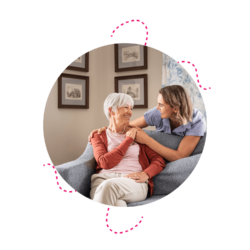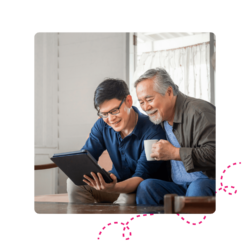The Critical Role of Software in Elder Care Management
Understanding Elder Care Needs:
As the world’s population continues to age, ensuring the well-being and quality of life of elderly individuals is crucial.
These individuals have been fully independent for most of their lives, many of whom have also raised their own families, and as such, have a unique set of needs and care requirements.
This is evident as many opt to live feely in their own homes rather than reside in residential homes, and whilst this can be the best choice for some, it is essential that all individuals have access to the resources and support they need to maintain as much of their independence as possible, regardless of where they choose to live.
As such, providers should create personalised care plans that are tailored to the unique needs and care requirements of the individual.
This means that it is essential that providers work closely with the members of the service user’s wider care team and other key stakeholders to create and implement a cohesive personalised care plan that will yield the best possible outcomes for the service user.
They should also actively engage and maintain high levels of communication with the service user’s family to keep them fully informed of their loved one’s progress and enable them to collaborate with care teams to rectify any issues that may arise during the care planning and delivery process.

Software Solutions for Customised Care Plans:
Care plans aren’t just about getting service users out of bed and dressed, bringing them breakfast, and then putting them in front of the tv; rather, they are about ensuring they receive the correct care and support they require in a way that empowers them to have as much independence and control over their lives as possible.
However, as everyone’s care requirements are different, each service user needs a personalised care plan, tailored to their own specific care requirements.
Creating personalised care plans manually can be a very time-consuming and administrative-heavy process for providers, but it doesn’t have to be!
This is where elder care management software comes in!
Elder care management software comes packed with functionality, such as a highly configurable document library, a centralised and easily shareable data repository and robust tagging functionality that streamlines the creation of personalised care plans.

The centralised nature of these digital care plans allows providers to consolidate service users’ medical and care history, lifestyle preferences, behavioural information, and more into the care planning process with ease.
Elder care management software also encourages the service user to take on a more active role in the care planning process and delivery processes, increasing collaboration, which ultimately leads to improved care outcomes and increased levels of satisfaction for both the service user and their care teams.
Elder care management software also typically comes with client and family portals, allowing key stakeholders to remain informed and enables collaborative decision making with the service user.
The comprehensive communication capabilities of aged care management systems facilitate clear and more inclusive communication, allowing elderly individuals to raise their concerns, voice their preferences, and communicate changes in how they feel.
Care assessments can also be completed digitally within the platform, empowering care teams to collect and analyse feedback from the service users, families, and team members to identify gaps in care delivery, improving the delivery of person-centred care and reinforcing a sense of dignity within the service user over time.

Compliance and Regulatory Regulations:
Aged care management software is designed with compliance at its core, ensuring providers can consistently achieve and maintain full compliance with national regulations.
Providers can update care records and incident logs at the point of care, with all key stakeholders being instantly notified.
Additionally, any action completed through the system will be recorded with a time, date, and author stamp, increasing transparency into the care being delivered and allows providers to easily compile reports for auditing purposes.
These systems also promote the standardisation of incident reporting, facilitating the recording of incidents and complaints in consistent detail, ensuring all key information can be recorded and shared with stakeholders.

Elder care management software operates on a permission and role-based basis, meaning staff only have access to certain data, protecting service user information and reinforcing their right to privacy.
Providers are also empowered to create audit-ready documentation by utilising the robust library of standardised documentation templates that have been created in line with regulatory standards.
Additionally, any actions logged in the system can be easily compiled into an audit-ready dashboard, which providers can use to proactively identify trends occurring and implement changes to rectify any issues which may be occurring.
Improving Family Communications:
Elder care management software is packed with digital tools designed to strengthen trust, increase transparency, and enhance the overall communication between care teams and the service user’s family.
The integrated nature of these tools enables family members to receive instant updates on their loved one’s care and are notified of any changes to their care plan or any other key tasks that have been missed.
The integrated nature of these tools enables family members to receive instant updates on their loved one’s care and are notified of any changes to their care plan and any other key tasks that have been missed.
Additionally, the service user’s family members can access their care record at any time through a secure family portal.
This increased visibility strengthens the trust between stakeholders and empowers them to remain fully engaged with the service user’s care.

Aged care management systems also use instant messaging functionality that allows the service user’s family to ask questions, respond to updates, and communicate directly with care teams, eliminating the need for handwritten notes and verbal updates.
As care tasks are completed, they are logged in the system with time, date, and author stamps, providing the service user’s family with increased visibility into the care their loved one is receiving.
By utilising digital communication tools, providers can have transparent and consistent communication with the service user’s family, increasing the levels of trust and satisfaction with the care being provided.
Technology Adoption Challenges in Elder Care:
Adopting and implementing a new technology can be challenging in any industry, and the care industry is no exception!
Some of the challenges providers across the industry face when adopting a new technology include, but are not limited to, digital literacy levels, inadequate training and support, and oftentimes, a cultural resistance to change.
When providers are looking to invest in an aged care management software, it is essential that they engage staff as early as possible in the process and provide them with adequate time to voice their feedback and any concerns they may have as the end user.
Providers should ensure they also have adequate training and ongoing support in place for your staff to ensure they can maximise the potential of the software as at the end of the day, there is no point in having technology with all the bells and whistles in place if your staff can’t use them to their maximum potential!
Providers who fail to have adequate training and support in place will oftentimes face backlash from staff and further increase their resistance to change.

Staff’s reluctance to adopt new technologies can be caused by a variety of reasons, such as the technology itself being too complex, they’re more comfortable using methods and technology that they have previously used, and oftentimes, generational attitudes to technology.
If the technology is too complex and not intuitive to staff, providers will struggle to get buy-in from their staff, and as such will struggle to adopt new technologies across their organisation.
Best Practices for Choosing the Right Software:
Choosing the right software for you and your care business isn’t just about picking a piece of software, it’s about choosing the right long-term software partner who will support you and your staff as you grow.
As a result, there are a number of things providers need to keep in mind when they are selecting a software solution for their organisation.
Whether you’re looking for compliance functionality, medication management, or even an all-in-one aged care management system, it’s fundamental that providers have a clear understanding of their pain points and how the software can help solve the issues they are facing.
It’s important that providers also consider their long-term goals and prioritise a system with functionality that will directly help them achieve their goals.
Providers should also look for an easy-to-use and user-friendly system, as the best software is intuitive, easy to navigate and doesn’t require an IT background to use.
Additionally, when researching elder care management software systems, it is important to verify that the software provider will provide onboarding support, training for all staff, and ongoing support to ensure your team feel confident and capable when using the system.

It is crucial that providers involve their staff as early as possible in the buying process, as their practical experience and insights will enable them to easily identify any limitations and functionality missing from the system prior to entering a contract with the software provider.
When choosing a new aged care management system, it is also important that providers choose a platform that can grow with their organisation, support additional services, and adapt to regulatory changes without requiring a significant overhaul.
Additionally, it is important that providers look beyond the initial upfront costs and consider costs such as training, ongoing support, and updates delivered.
The right software should also pay off in efficiency and outcomes, not just the amount of money saved.
Finally, when considering different elder care management software, providers should chose vendors that have a strong reputation within the industry, clear pricing models, and a commitment to ongoing development as it’s not just about choosing a piece of tech, it’s also picking the right long term partner who will support you, your staff, and your service users as you grow.
Ready to transform elder care? Book a demo with OneTouch Health to see how our digital care management system can streamline care planning, improve compliance, and transform outcomes.

